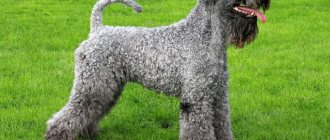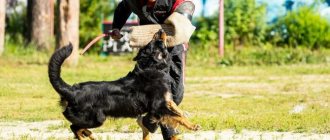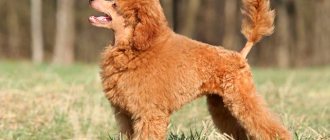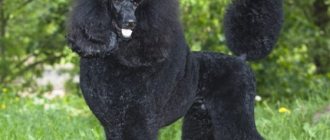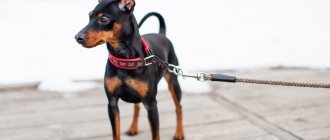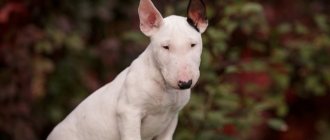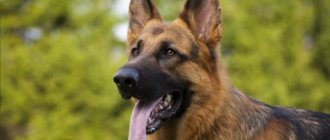brief information
- country: France;
- name of the breed: Breton Spaniel, Breton Spaniel, Breton Spaniel;
- purpose: hunter, companion;
- main color: white with red, black or brown;
- life expectancy: 12-15 years;
- weight: male 15-19 kg, females 15-16 kg;
- height: male - from 45 to 52 cm, females - from 43 to 51 cm;
- average cost: 25-45 thousand rubles.
Exceptional Hunter
Breton Epagnol can work on both poultry and game. Its small size is a definite advantage: it allows it to easily sneak under the overhanging branches of dense forest thickets. According to the terrain conditions, he is able to change his hunting method (adapt). The Breton Epagnole has an innate passion for hunting, which has a positive effect on the prey ability of dogs of this breed.
It combines innate qualities: stance and confident search, clean delivery, while displaying high mental abilities.
History of the breed
Breton epañol originated in one of the remote, agricultural regions of France and there is no reliable information about its origin. All that is known for sure is that the breed appeared in the French province of Brittany around 1900 and within a hundred years became one of the most popular dogs in France.
The first written mention of the breed dates back to 1850. Priest Davis described a short-tailed hunting dog that was used for hunting in northern France.
At the beginning of the 20th century, the Breton Epagnole was already quite famous in its homeland and even participated in a dog show held in Paris in 1900.
Another description of the breed was made by M. Le Comte Le Conteulx de Canteleu, who compiled a list of French breeds, among which was the Epagnole Breton. It was he who first mentioned the breed under this name.
The first detailed description was first created by cavalry major and veterinarian P. Grand-Chavin in 1906. He described small spaniels, with short tails or even tailless, extremely common in Brittany. He also mentioned colors: white and red, white and black, or white and chestnut.
These are exactly the same colors that are found in the breed today. In 1907, a male Breton Epagnole named Boy became the first dog officially registered with the canine organization.
In the same year, the first breed standard was drawn up. These dogs were originally called Epagneul Breton Queue Courte Naturelle, which translates to “short-tailed Breton dog.”
Description of the Epagnole breed
The Epagnole Breton is a small animal, one of the smallest among other representatives of the cops. These dogs are stocky, solid in appearance, but at the same time they give the impression of some grace.
Height. These gundogs grow up to 49 cm for females and from 50 to 60 cm for males, of course, we are talking about the height of the animals at the withers.
Weight. The average weight of dogs is from 13.5 to 18.5 kg.
Head. Regular shape, slightly rounded, with smooth transitions. The eyes are large, almond-shaped, rounded, the ears are triangular, in constant movement, the nose is fleshy, not necessarily black, it often matches the color.
Body. The body is very proportional, the neck is developed, muscular, and the chest is wide. The abdomen is tucked in, but not sunken.
Tail. As for the tail, contrary to many misconceptions, it is not docked. Dogs are born with a very short tail, and sometimes without one at all. World standards allow the length of this organ to be up to 10 cm; at exhibitions, the ideal length is considered to be from 3 to 6 cm.
Limbs . Strong, without curvature, thighs are noticeably wider than the shins, which, in turn, are longer than the thighs.
Wool . The pile is slightly wavy and thin, with pronounced fringes. Color – white, with spots of various colors. As for the shortcomings or defects of the breed, the dog will be disqualified at any exhibition if it has:
- defects in behavior and demonstration of inconsistency of character is aggression. Cowardice, lack of curiosity;
- violation of proportionality and difference from size requirements, including weight;
- sharp transitions in the lines of the head;
- white spots around the eyes - this is considered a sign of degeneration;
- bite defects.
However, if the Breton epagnole is bred for hunting , these requirements fade into the background compared to the working qualities of its parents, and according to its heredity in this aspect.
Purpose of the breed
Based on the characteristics and description of the breed, the Breton Epagnole is an intelligent and attentive dog. She has an excellent sense of smell and is excellent at fetching game.
Interesting! Representatives of this breed are active in any area. They are considered good climbers.
The Epagnol Breton is rightfully considered a universal hunting dog. During the hunt, the animal is characterized by tireless endurance, so it can hunt throughout the daylight hours. Most often, these animals are used for hunting game birds. In Britain, these dogs are used to hunt rabbits and foxes.
Application
Today, the French epagnole is started as a companion. He gets along with any family and adapts to people's lifestyles.
However, the purpose of the Breton epagnol is hunting game birds. It is used to track partridges, pheasants, woodcocks, and quails, although the pet handles all birds equally well. The dog is tireless and can work all day. It is equally good in the field, forest and on ponds.
In the heat, the dog is allowed to rest and cool down every hour - otherwise he will develop heatstroke or sunstroke.
The Breton Spaniel has an excellent sense of smell. He can smell a bird 70 -100 meters away.
If the French Cocker Spaniel takes birds on its wing, then the Breton Spaniel is a hunter of a different order. He combs the field with a shuttle at a distance of 50-100 m in each direction. And when it senses prey, it freezes in a stance and patiently waits for its owner. Only when he approaches does the dog carefully approach the bird. Moreover, a quail or a pheasant is often scared away by a person so as not to expose the pet to a gun.
Some Breton epagnols master the highest art of cops - an announcement or a report. When the dog smells game, it carefully leaves the stand, looks for the owner and leads him to the bird left for a while.
Appearance
The Breton is a dog with a very strong skeleton. The head is round in shape, wide with a noticeably protruding muzzle. The lips are thin, the eyes are lively and expressive, dark amber in color. The ears are set high and slightly rounded.
The body is short. The croup is sloping, the chest is deep. The tail does not exceed 10 cm in length, and in some representatives of the breed it may be completely absent.
The hind limbs are powerful, and the forelimbs are thin and light. The coat is slightly wavy, there is no undercoat. Bretons come in black and white, tan and white, roan, chestnut and white, and white, black and orange.
Disadvantages and disqualifying vices
German Spitz (small): description of the breed, character
Despite the huge number of advantages, this breed, like any other, has disadvantages. The most obvious are the following:
- timidity;
- wandering gaze;
- lack of security qualities.
All purebred dogs must meet certain standards. Disqualifying faults include:
- short hair all over the body;
- short neck with dewlap;
- bulging, round or almond-shaped eyes;
- a long tail;
- straight bite;
- uneven teeth;
- depigmented nostrils or nose.
Description
Although the Breton Epagnole is a spaniel, it is definitely not like these fine dogs. Spaniel traits are present in it, but they are less pronounced than in other breeds in this group.
This is a medium-sized dog, males reach from 49 to 50 cm at the withers and weigh 14–20 kg. This is first and foremost a hunting dog and should look the part.
The Epagnole is muscular and very strongly built, but should not appear thick or stocky. Of all spaniels, he is the most square, being approximately equal in height to length.
British Spaniels are known for their short tails, and some are born without a tail. Docking is also acceptable, but it is extremely rare for them to have a tail longer than 10 cm.
The head is typical of a hunting dog, proportional to the body, but not very large. The muzzle is of medium length, the eyes are set deep and protected by heavy eyebrows.
Dark colored eyes are preferred, but dark shades of amber are also acceptable. The color of the nose corresponds to the color and can be dark pink, brown, or black.
The ears are of medium length, but quite short for a spaniel. Their coat is slightly longer, but without feathering, like other spaniels.
The coat is long enough to protect the dog when moving in the bush, but should not hide the body. It is of medium length, shorter than other spaniels, straight or wavy, but not curly. Despite the fact that the coat is very dense, the Breton Epagnole does not have an undercoat.
On the paws and ears the hair is longer, but does not form fringes. Almost every major canine organization has its own requirements for color. The most famous colors are white and red, white and black, or white and chestnut.
Origin of the Breton Epagnole breed
The country of origin of the species cannot be determined for certain, but the French consider it their national breed. Breton dogs are called epagnoles and spaniels. There is a version suggesting their relationship with Spanish bird dogs. The word "epagnole" comes from Old French and means - to lie down. Previously, birds were hunted not with weapons, but with nets. To ensure that only the prey fell into the trap, the dogs, upon discovering the game, stopped and then lay down. Many cynologists, based on the name “spaniel”, which means “Spanish” in French, claim that its homeland is Spain.
Disadvantages and disqualifying vices
German Spitz (small): description of the breed, character
Despite the huge number of advantages, this breed, like any other, has disadvantages. The most obvious are the following:
- timidity;
- wandering gaze;
- lack of security qualities.
All purebred dogs must meet certain standards. Disqualifying faults include:
- short hair all over the body;
- short neck with dewlap;
- bulging, round or almond-shaped eyes;
- a long tail;
- straight bite;
- uneven teeth;
- depigmented nostrils or nose.
Character traits
Representatives of this breed treat everyone well, they are happy to see even people they don’t know, so using them as watchmen and security guards will not work.
Bretons become very attached to their owner and do not tolerate loneliness well. Therefore, if you need to leave your pet alone, before doing so, you need to provide him with a long and active walk, so that in the absence of his owners, the dog sleeps, restoring his strength.
These dogs are smart and amenable to training; the main thing is not to scold your pet during the training process, much less physically punish it. This will only lead to the pet growing up scared and insecure.
Bretons are friendly and have an affectionate disposition, but do not think that they lack firmness and inner strength. Representatives of this breed can be quite stubborn and assertive, which is why it is important to raise and socialize them correctly. These dogs are by nature wonderful companions, which explains their desire to always be close not only to their owner, but also to people in general. When getting such a pet, you should remember that these are true hunters, so it is advisable to use them for their intended purpose, taking them with you hunting, or at least provide them with regular and active walks and physical activity.
Relationship with other pets and children
Representatives of this breed get along well with children, play with them and patiently endure their pranks. At the same time, if the child is under school age, it is better not to leave him alone with the pet.
Breton Spaniards love to be the center of attention, but they do not tend to dominate and do not pretend to be leaders. Therefore, representatives of this breed, subject to proper and early socialization, get along without problems with other animals, including cats and birds.
Character
Breeders carefully monitor the working qualities of these dogs and their character is typical of a gun dog. But they are also distinguished by their good nature. Most become nice family dogs after returning from hunting. They are attached to their owner and friendly to strangers.
These qualities make the breed completely unsuitable for guard work; they will happily welcome a stranger into the house. With proper socialization, Bretons get along great with children and are often the best of friends.
Even when compared to sweethearts like the Golden Retriever or Cocker Spaniel, they win and are one of the best hunting dog companions.
This is an obedient dog, it is easy to train and if you are about to get your first hunting dog or want to take part in obedience competitions, then this is an excellent candidate. However, you cannot leave her alone for a long time, as they suffer from loneliness.
Although these dogs usually work alone, they are capable of working in a pack and prefer the company of other dogs. The Bretons are unfamiliar with dominance, territoriality, and jealousy.
Very rare dogs bully others; they get along calmly with them. Surprisingly, for a hunting dog, it has a high level of friendliness with other animals. The cops must find the bird and bring it to the owner after the hunt, but not attack. As a result, most Bretons are very gentle with other animals.
This is one of the most trainable dogs and it performs well in training. Her level of intelligence is very high and she is not out of the top 20 smartest dogs. She easily performs tasks that baffle other dogs. If you lack experience in training, then this is one of the best dogs.
Breton epagnoles would suit almost any family if they did not require a high level of activity. For their size, they are extremely ill-suited to apartment life and even the immediate suburbs. They need a load and a high load. Only some herding dogs and terriers can compete with them in this.
A simple, albeit long, walk is not enough for them. Breton is able to hunt for 9-10 hours without a break, regardless of the weather. An hour of running or other activity per day is required, at a minimum. At the same time, they practically do not get tired and are able to drive the owner to death.
It is extremely important to meet her exercise requirements, since all behavior problems stem from unspent energy. The dog may become destructive, nervous, and timid.
Keeping a Breton Spaniel and not loading it is equivalent to not feeding or watering it. The best workload is hunting, for which the dog was born.
Education and training
Breton dog training should begin as soon as the puppy reaches 4 to 5 months of age.
During classes, it is recommended to be persistent and demanding. In no case should training be accompanied by shouting or physical punishment. The pet should be praised more often and be sure to reinforce the praise with treats.
Additional Information! Espanyol is a very smart dog, so there are no problems during training.
In order to hunt productively with your pet, it must be taught:
- look for game with a shuttle;
- calmly react to the sound of a gunshot;
- freeze for a long time in front of a hidden bird in a stance;
- look for shot game;
- without damaging, bring the prey to the owner.
Appearance
Miniature Poodle: description of a miniature breed
The Breton is a dog with a very strong skeleton. The head is round in shape, wide with a noticeably protruding muzzle. The lips are thin, the eyes are lively and expressive, dark amber in color. The ears are set high and slightly rounded.
The body is short. The croup is sloping, the chest is deep. The tail does not exceed 10 cm in length, and in some representatives of the breed it may be completely absent.
The hind limbs are powerful, and the forelimbs are thin and light. The coat is slightly wavy, there is no undercoat. Bretons come in black and white, tan and white, roan, chestnut and white, and white, black and orange.
Care and maintenance of epagnol
It’s not enough to buy an epagnol , the dog still needs to be raised. In addition, you should clearly understand why this puppy is being acquired, what it should grow up to be - a companion, a family dog, a star of the show rings, or a hunter. This is what will determine from which breeders you should take a puppy into your home.
Regardless of your goals, raising a fur baby requires patience, care, free time, kindness and firmness, but not cruelty. If a person is busy all day long, but he needs a dog once a season to go hunting with friends or for company for evening walks, there is Epagnole puppies , it is worth paying attention to already adult dogs, which, for one reason or another, are given away either they sell.
As for keeping the animal and caring for it, this dog does not require much. The main points in the content, in addition to feeding, of course, are:
- regular brushing;
- a long evening walk with the opportunity to run without a leash;
- games with animals;
- regular preventative examinations at the veterinarian.
It is worth understanding that the Epagnole is an attentive and quite active dog; of course, this animal will happily watch a movie with its owner, lounging next to him on the sofa, but before that you will have to walk with him for a couple of hours, and perhaps go for a run or ride a bike.
As a city dweller, this animal will be an ideal friend for those who go jogging and generally try to play sports in the fresh air.
Wool and bathing
Comb the coat 2-3 times a week, paying special attention to the fringes, since this is where tangles most often appear and thorns and grass get tangled in them.
The dog should be bathed as needed, but not more than once a month.
Ears
Inspect and clean the ears weekly from wax and dust with a cotton pad soaked in a special product or peroxide.
Claws
With regular active walks, the Breton's claws are ground down to the required length on their own. If this does not happen, they must be shortened with a guillotine nail cutter every 3-4 weeks - this prevents the so-called “unraveling” of the paws.
Eyes
Every morning, wipe with a lint-free cloth soaked in tea leaves or chamomile infusion.
Teeth
To prevent the appearance of plaque and tartar, your pet’s teeth should be brushed weekly using a special paste and brush for dogs. You should also give your Breton dog treats and chewing toys that help mechanically clean the teeth.
Walk
The dog has irrepressible energy and is ready to walk at any time of the year, under any conditions. In an apartment you will need to walk the dog at least twice, but it is advisable to do this three times. Try to keep your pet occupied with games and provide as much movement as possible.
Nutritional Features
Most breeders prefer to feed their dogs commercial dry food because it is convenient and does not require much time to prepare the food.
In addition, dry food contains all the necessary minerals and vitamins, and the special composition with which the granules are processed helps clean teeth. It is important to choose only high-quality food that does not contain chemical flavors, flavor enhancers and dyes. The most suitable diets for representatives of this breed are made by the brands Acana, Orijen, Happy Dog, Royal Canin, Arden Grange, 1st Choice, Artemis, Almo Nature, Brit Premium, Canidae.
Natural feeding gives the owner the opportunity to independently choose the freshest and highest quality products for the dog, and the fact that all the nutrients in them are of natural origin improves their absorption by the pet’s body. A significant disadvantage of this diet is that it requires a lot of time to prepare food for the dog every day.
If you decide to feed your pet natural products, you should take into account that the diet must be balanced, and the diet must include:
- sea fish (cod, pollock, pollock, flounder, mullet, trout, hake);
- lean meat (beef, veal, turkey, chicken);
- porridge (rice, buckwheat, oatmeal);
- offal (heart, liver, lung, tripe);
- seasonal vegetables and fruits (carrots, pumpkin, bell peppers, zucchini, apples, bananas, pears);
- boiled eggs (no more than 2 per week);
- low-fat fermented milk products (cottage cheese, kefir, natural yogurt).
You should also give your pet a small amount of vegetable oils, which have a beneficial effect on the quality of the coat, and cartilage and tendons, which are beneficial for bones and joints.
The list of prohibited products includes:
- legumes;
- fat meat;
- river fish;
- potato;
- cabbage;
- smoked meats and sausages;
- fried and salty foods;
- citrus;
- tubular bones.
PLEASE NOTE! With natural feeding, the dog must be given an additional complex of vitamins and minerals.
Health of the Breton Epagnole
Breton Spaniards are a fairly healthy breed. On average they live up to 12 years. To keep your dog in impeccable shape, you need to feed it well. Therefore, first of all, carefully consider your diet. It is through food that the animal receives the substances its body needs. To achieve optimal results, your pet must receive the required amount of protein, fat, carbohydrates and mineral salts. A balanced diet is a necessary prerequisite for the harmonious development of the body, preparing the dog for an active, adult life, increasing resistance to infections and diseases.
Dossier
Adult height : male 47-52 cm, female 46-51 cm. Weight: 14-16 kg. Characteristic color: white and orange or red, white and black, white and dark chestnut, with more or less extensive irregular white spots. Coat length: medium. Life expectancy: 12-16 years. Advantages of the breed: good endurance, energy, friendly attitude towards children and adults. Difficulties of the breed: excessive shyness, aggressiveness, lazy behavior. Average price: puppies 200-300 dollars, adults 400-450 dollars. Classification: medium; Spaniel/pointing dog, hunting dog.
Choosing a Breton Spaniole puppy
Since Breton epagnoles came to Russia and Ukraine relatively recently, there are very few nurseries here:
- “Fields of Russia” (Moscow);
- Breton Hold (Moscow);
- “Free Wind” (Kyiv);
- Bretonique style (Zaporozhye).
A pet-class Breton Epagnole puppy can be purchased for 15 thousand rubles, intended for hunting - for 35 thousand rubles, and for participation in exhibitions - for 60 thousand rubles. In our country, it is very difficult to purchase show-class animals, because breeders keep them for further breeding. In this case, you can go abroad. But in France the breed is so popular that you will have to stand in line for the planned mating.
When choosing a small Breton, pay attention to:
- the reputation of the kennel, which must be a member of RORS (Rosokhotrybolovsoyuz), RFOS (Russian Federation of Hunting Dog Breeding) or RKF (Russian Cynological Federation);
- pedigrees and titles of producers;
- the appearance of the parents and their compliance with the breed standard. One of them must have a short tail of natural origin;
- the puppy has a veterinary passport with vaccination and deworming notes;
- appearance (teeth, color) and behavior of the baby (balance, activity, curiosity) - there should be no physical or behavioral defects.
Conscientious breeders give away Breton Epagnole puppies no earlier than two months of age
How much do puppies cost?
The price of Breton epagnoles is relatively low. The average cost of a puppy is 20,000 thousand. They hand over 5-10 thousand rubles for a treat.
The most expensive show class puppies. They ask for from 35 to 60 thousand rubles. Working Breton epagnoles are cheaper - 25-30 thousand rubles.
Mating
Physically, the Breton Spaniel matures quickly. The first estrus in bitches begins at 5-7 months. However, they are untied from 1.5 years, and males - from 2 years.
On average, pregnancy lasts 62 days. It may shift downward or upward by 5-10 days. Breton Epagnoles have 4-5 kittens in their litter.
Pregnancy
During pregnancy, the Epaniola bitch needs special treatment:
- after mating, it is worth limiting the bitch’s physical activity, especially hunting;
- equip her with a place in advance where she can hide;
- increase the number of walks, slightly reducing the time spent on the street;
- the diet should be revised, starting from the fifth week, in the direction of increasing calorie content;
- the menu of a Breton Epagnol female should contain many sources of collagen and minerals;
- from the eighth week they begin to prepare for childbirth.
Training
Starting from the age of three months, you can gradually begin to train your Breton. During this period, the puppy especially listens to its owner. Commands should be spoken in a soft voice. If the pet has correctly fulfilled the requirement, it needs to be praised and encouraged in some way. Otherwise, you can raise your voice a little.
In order for the puppy to quickly get used to his nickname (it is better if it is short), it should be repeated as often as possible.
You need to call the dog to you more often, pronouncing his name in a gentle voice. As soon as he runs up, you can treat him with something tasty or cuddle him. The baby will remember this pleasant moment and next time he will joyfully come running at the first call. A Breton must understand the word “no”. If he did something wrong, you can pat him on the sacrum. Accustoming to cleanliness. Every time after sleeping, eating and active games, the Breton should be taken outside to do his business. Otherwise, there will be piles and puddles in the house every 2 hours. When the puppy does his business in the right place, he must be praised, as if he had performed some kind of miracle. This way the Breton will quickly understand that his actions are correct and will try in every possible way to please his owner.
Breton epañol
Interesting facts about the Breton Epagnol
They have won more dual meets than all other breeds. That is, they can be used not only in natural conditions, but they also perform in the ring.
Despite the fact that they can work at a great distance from the hunter, they never let him out of their field of vision. This makes training dogs very easy. They carry out any order. A person only needs to point in the direction, and the dog will tirelessly “iron” the field in search of prey. Neither prickly grass nor other smells are able to distract him from his favorite activity. To say that the sense of smell of these dogs is wonderful is to say nothing. In France they say about a person with excellent intuition that he has a nose like an epagnole.
They can, as hunters say, “pick up the scent” from a great distance. In open areas, they can smell a flock of birds at a distance of almost 70 meters. They have a very sensitive nose, which turns them into real hunting machines. It's big, wide and open. Allows you to breathe deeply and smell more. Bretons have a sense of smell 25 times stronger than that of humans.
Theses
- This is a very, very energetic dog. She needs at least an hour of intense exercise a day, without which she can become destructive.
- In addition to the body, you also need to exercise the mind, since the Bretons are very smart. Ideal for training and sports.
- These dogs try to please their owner and there is no need to treat them roughly.
- They love people and do not like to remain for a long time without communication with their owner. If you are away from home for a long time, then get her a companion.
- They are friendly and love children.
- Do you want to buy a Breton Epagnole? A puppy will cost from 35,000 rubles, but these dogs are quite rare in Russia and cannot be found everywhere.
Sources
- https://PetGuru.ru/porody/bretonskij-epanol
- https://epagneulbreton-mooir.ru/
- https://givotniymir.ru/epanol-sobaka-opisanie-osobennosti-cena-i-uxod-za-epanolem/
- https://gafki.ru/sobaki/bretonskiy-epanol.html
- https://dogipediya.ru/porody-sobak/srednie/bretonskij-epanol
- https://tutknow.ru/animals/6336-opisanie-porody-bretonskiy-epanol.html
- https://domashnij-zapovednik.com/sobaki/porody-s/spaniel/bretonskij.html
- https://prohvost.club/sobaki/porody-sobak/bretonskiy-epanol-foto.html
- https://catfishes.ru/bretonskij-epanol/
[collapse]
